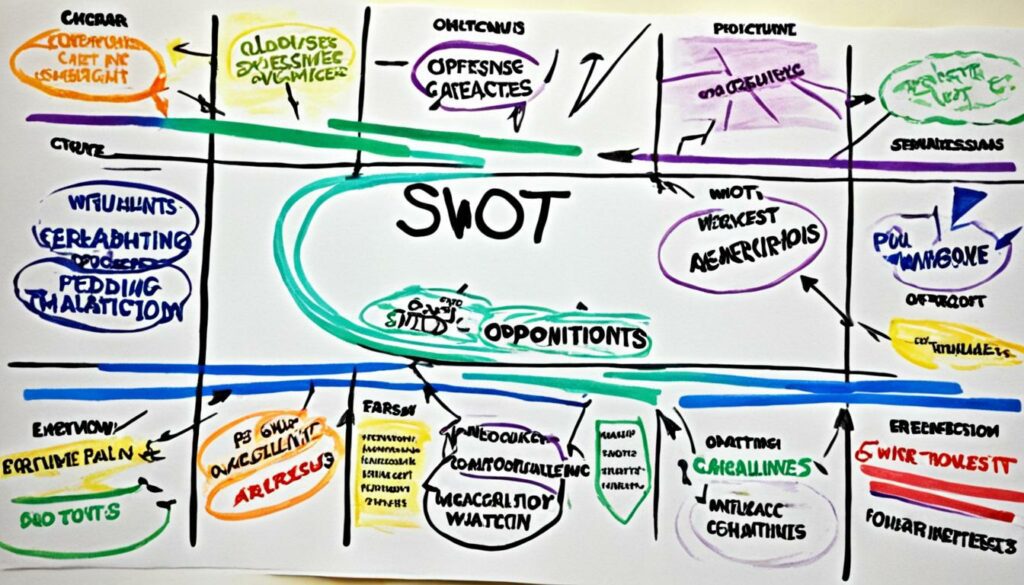Menu

Do you know that doing the right market analysis can increase your ROI by 140-400% in three years? This huge jump in returns shows why it’s so important to get market analysis right. This guide will show you how to use market analysis to beat your rivals. Market analysis looks at both numbers, like market size, and people’s feelings and desires.
Market analysis is key in spotting industry changes and chances for growth. It helps tweak your marketing and make your plans stronger. It’s important to know the differences between market analysis, market research, and marketing analytics. Market analysis looks deep into market dynamics. Market research gathers info on specific markets. And marketing analytics uses data to increase ROI.
Market analysis looks closely at who a business aims to reach, as well as its competitors. This deep study is key for creating a solid business strategy and fully understanding the target market. It helps by looking at what customers like and how other businesses are doing. This way, businesses can guess how well they might do, see what people are happy to pay, and guess how much money they might make.
By using top-notch marketing analytics in your study, you can make your marketing budget work harder. This can mean seeing up to 400% more profit over three years. It shows why it’s vital to know how good a company is at using analytics. This affects how well they can change their market strategy to increase profits.
Market analysis is more than just guessing about money. It helps businesses use their resources better by pointing them towards the most promising areas. This lowers costs and increases profit. Doing a deep market analysis means you know the market trends and the big companies in it. This makes business risks much lower.
Doing market analysis regularly helps spot new trends first. This gives businesses a head start by allowing them to take new chances before their competitors. Predicting the market’s future makes it easier to make smart choices. This way, companies can make sure their products or services are what people really need.
Looking at Key Performance Indicators (KPIs) through market analysis gives businesses goals to aim for. Even though it might take a lot of time and money, it’s worth it in the long run. Good market analysis not only shows where there’ve been mistakes but also helps make products and services that fill real needs.
A thorough market analysis can improve a business’s strategic decisions greatly. This article looks at the many benefits and how they help.

Finding emerging trends and industry chances is crucial. Market research helps understand different customer groups. This knowledge lets businesses make better marketing strategies and improve customer interaction. It also helps find new consumer groups, start new business relationships, and make better products.
Market analysis is key to reducing risks. It lets companies make decisions based on data, which cuts down on marketing expenses. Testing new product ideas through research is essential, as most new launches fail without meeting a market need. Knowing your market reduces risks and helps pick the best ways to market to your audience.
Market analysis helps companies tailor what they offer to what customers want. Segmenting customers by their buying habits and preferences helps in product design. This approach boosts customer happiness and makes a business more competitive.
| Benefit | Impact | Statistic |
|---|---|---|
| Spotting Trends | Identify new market segments | 60% increase in profitability for customer-centric businesses |
| Risk Minimisation | Reduce risk for new ventures | 95% of new products can fail without market research |
| Product Customisation | Tailor products to customer needs | Enhanced engagement and brand reputation |
Market research helps businesses gather and analyse data about markets or audience groups. This data guides important strategies. It uses both numbers and personal insights to get a full view.
Quantitative methods deal with number-based data. Surveys are a common tool, asking questions in various ways. They are flexible and allow for detailed collection.
Social media listening is also a part of this. It tracks mentions and feelings about brands on social platforms. Experiments and field trials add the aspect of cause and effect, helping to understand how changes affect outcomes.
Qualitative methods look into the meanings and reasons behind consumer actions. Focus groups bring together small numbers of people to talk freely. This can uncover insights missed by general surveys.
Interviews offer one-on-one discussions with participants, giving detailed feedback. Ethnographic research is about watching people in their everyday settings. This can provide deep understanding by observing behaviour in real life.
Using both quantitative and qualitative approaches together gives a complete market insight. Quantitative data gives the facts, while qualitative offers the stories behind them. This mix helps businesses fully understand what customers need, leading to better decisions.
Getting a balanced view from various research methods is key for making informed strategies. This ensures the research is both detailed and actionable.
Understanding the market is key for any business. Industry analysis helps companies predict needs, supply, and profits. Tools like SWOT and PESTLE help companies look at their competition and the market easily.

SWOT looks at a business’s internal strengths and weaknesses. It also looks at the outside opportunities and threats. This helps in making better business choices.
PESTLE examines the outside factors that affect businesses. It includes things like politics and the environment. Knowing these factors helps in making business strategies that work in the wider world.
Porter’s Five Forces looks at the power of competition in the market. This includes how strong the competition is and how easy it is for new businesses to enter. It helps firms know where they stand in the market and how to improve.
For a business aiming for success, knowing its competitors is key. Effective strategies help in this. They let companies spot key rivals, check their good and bad points, and see where they stand in the market. Let’s look at these strategies to improve our understanding and get ahead.
To do a good competitor analysis, start by naming and sorting competitors. You’d group them as direct, indirect, legacy, and emerging rivals. Knowing these types helps in planning your competition study. It shows the different impact each has. Here’s a brief on them:
Meaningful competitor analysis involves spotting what others do well or not so well. You look at their main things they offer, prices, and what customers say. Use both opinions and numbers to really get the competition. Important things to think about are:
| Aspect | Details |
|---|---|
| Primary Offering | Look at their main products or services. |
| Pricing Strategy | Check their prices and what they bring for that price. |
| Customer Feedback | Review what people say to get a sense of their reputation. |
Comparing their strong points helps set goals for success. This also guides you in making your strategies better than theirs.
The last step includes knowing where competitors stand compared to us. This means placing them on a map based on their market reach and how happy their customers are. Doing this shows what the top players do differently. It also hints at where we can do better with our plans. Using smart tools to study their marketing, social media, and content helps. Here’s how:
Regularly checking on your rivals is crucial to being quick and fitting in with how consumers and tech change. This kind of knowledge helps a business not just get by but do well in a crowded market.
A SWOT analysis helps businesses spot their strengths and weaknesses. It also shows them what opportunities and threats lie outside. This tool is key for smart planning and making decisions based on facts. Now, let’s see how a SWOT analysis works.

The first step in SWOT analysis is looking at what’s inside the company. Strengths are anything that gives a business an edge. It could be a famous brand, lots of repeat customers, or special tech. Finding these strengths is vital.
But, there are also weaknesses like a high staff turnover or slow processes. Knowing these lets the company work on fixing them.
What’s happening outside the business is important too. Opportunities are good chances a company can use to get ahead. They might be new markets, better tech, or what customers want next.
On the flip side, threats are the dangers like more competition or new laws. Seeing these threats early can help a business plan to deal with them.
After listing the strengths, weaknesses, opportunities, and threats, it’s time to plan. This is where the magic of the SWOT analysis happens. Companies use what they’ve found to make real plans. They want to win with their strengths, fix weaknesses, grab opportunities, and face threats head-on.
Usually, all this info looks best in a table:
| Internal Factors | External Factors |
|---|---|
| Strengths Strong brand, Loyal customer base, Proprietary technology | Opportunities Emerging markets, Technological advancements, Market gaps |
| Weaknesses High turnover rates, Inefficient processes, Outdated technology | Threats Rising material costs, Increased competition, Regulatory changes |
Applying the SWOT analysis process well gives businesses a full view. They see challenges and chances clearly. This helps them grow steadily and stay ahead.
The PESTLE analysis framework helps explore external factors affecting a business. This includes political, economic, social, technological, legal, and environmental elements. By analysing these, companies can prepare for key challenges and opportunities.
Political decisions, trade, rules, and global events shape business environments. The Paycheck Protection Plan and tariffs on imports are recent examples. These factors influence how companies operate and make money.
Inflation, how much people spend, supply chains, and overall economy matter. They affect prices, what people can buy, and markets. Knowing these helps companies predict and adjust to economic changes.
Cultural trends, changes in demographics, and customer behaviours are social factors. They guide your product and service design. On the other hand, tech advancements like AI and tools for working from home bring new chances and risks. Staying up-to-date here is key to staying ahead.
| Factors | Considerations |
|---|---|
| Political | Government policies, trade relations, regulations |
| Economic | Inflation rates, consumer spending, supply chain dynamics |
| Social | Cultural trends, demographic changes, consumer behaviours |
| Technological | Advancements in AI, cryptocurrency, cybersecurity |
Using PESTLE in planning helps predict risks and spot chances. It lets companies deal with the many external challenges. By scanning the environmental scene deeply, firms can change and grow. This ensures they are strong and successful in the long run.
Today, knowing how to use data insights is key to business success in a competitive market. Several analytics methods are important for looking at market data thoroughly. This helps marketers make smart choices.
Data analytics is vital for understanding market trends, consumer behaviours, and what the competition is doing. By using Descriptive, Inferential, Regression, Content, and Predictive analytics, we gain insights into both types of data. Descriptive analysis, for example, summarises data like social media likes. Inferential analysis helps make decisions based on lots of data.

The insights from these methods help businesses target their marketing, predict the market, and do better.
Using the right data analytic tools is crucial for handling market data well. Tools such as Google Analytics, Microsoft Power BI, and SAS software help connect the dots in data. For instance, Regression analysis shows how marketing spend affects revenue. This gives useful information for future decisions. Content analysis tools help understand what customers think.
By combining different data types with these tools, companies can have a full view of the market. This helps improve marketing and beat the competition.
Advanced data analytics methods are key for staying ahead in the dynamic market. They help make decisions using detailed and accurate data analysis.
The use of marketing intelligence methods is key in today’s fast-moving business world. It provides a structured way to collect information. This helps companies to make smart choices that boost their growth and edge in the market.
A key part is gathering and studying data about who a company’s customers are. This includes details like age or likes. Knowing this helps businesses to aim their marketing directly at these groups.
Looking closely at what customers do when they buy and what they like is also very important. By listening to customers and studying what they say and do, companies can improve their products and how they sell them. This makes customers happier and more likely to keep buying.
To put these methods into practise, companies first have to set clear goals. Then, they choose how to collect data, use tools to understand the data, and create plans based on their findings. It’s also essential to keep checking how well these plans are working and adjust them if needed.
Forbes says starting by knowing who the target audience is can guide companies to messages that sell well.
Good techniques in marketing intelligence involve having a team just for this work. Using the latest tech, like tools that scan social media, can be a big help too. Everyone in the company should work together to use what they learn from these intelligence methods.
But, remember, there are challenges like keeping data reliable and following privacy rules. Coping with too much data needs a plan. This is why managing the data smartly is important.
| Steps in Implementing Marketing Intelligence | Description |
|---|---|
| Defining Objectives | Setting clear and actionable goals for intelligence gathering. |
| Choosing Data Collection Methods | Selecting appropriate tools and techniques for data acquisition. |
| Data Analysis | Utilising statistical tools to derive meaningful insights. |
| Developing Recommendations | Formulating strategies based on analysed data. |
| Monitoring and Evaluating | Continuous assessment to refine and improve strategies. |
In summary, good marketing intelligence methods give companies what they need to succeed in today’s changing markets. By listening and studying the market, firms can choose the best paths for growth. This leads to them getting ahead and staying strong.
By using these tactics, companies learn more about their market and what customers want. This leads to better results overall. Using intelligence wisely is a big step to doing well in the markets of today and the future.
In today’s world, spotting what customers need but don’t have is key. Doing this can give a business a big edge. To do it well, we need to use different methods. This helps us find and fix these gaps.

Finding what customers are missing is crucial. Companies like Canva and DocuSign lead by making tools for everyday people and secure document signing. They saw what people needed through watching how they used their apps and surveys.
By understanding customer needs deeply, they made products that solved real problems. This shows how important it is to pay attention to users and find new ways to help them.
Spoting market gaps opens doors to new ideas and ways to be different. Tools such as Hootsuite or Brandwatch can find what’s missing in the market early. They do this by listening to what people say and looking at what others offer.
Zoom grew a lot by listening to customers during the pandemic. By doing this, they increased their users by a lot. By always looking ahead and listening, a company can stay popular.
Knowing what the market wants needs many ways to look. This includes online listening, surveys, talking to focus groups, and doing research. Zoom used feedback to grow a bunch during the pandemic.
Staying ahead means always looking at what people search for online and what’s happening in the industry. This helps a business change with the times and find new chances to do well.
Knowing your potential customers is key to growing any business. It involves looking closely at what consumers want. This way, companies can make marketing that fits them perfectly. Using info like age, lifestyle, and what they do, businesses can get more customers and sell more.
Dividing customers by things like age and job helps in marketing directly to them. If a group has more money, you might want to sell them luxury items. This can boost how much they buy from you.
Looking at consumers’ lifestyles and what they value helps understand their choices. It lets businesses connect their message and products with what the customers love. This approach can make products stand out and keep customers happy.
Seeing what customers have bought before and how they act with brands gives a lot of insights. By watching places like Quora, businesses can learn what’s needed right now. This, plus surveys, offers a full picture of what customers really want.
Making profiles based on who your customers are and what they like is crucial. It not only makes customers happier but also helps businesses make smart choices. These choices lead to growth even in tough markets.
| Aspect | Criteria | Benefit |
|---|---|---|
| Demographic Analysis | Age, Gender, Income level, Family size, Occupation | Enhanced targeting accuracy |
| Psychographic Profiling | Lifestyle, Values, Personality, Interests | Deeper consumer connections |
| Behavioural Insights | Past actions, Purchase patterns, Interaction with brands | Improved engagement and loyalty |
Entering a new market has many challenges. These can hurt a business’s chances of doing well. McKinsey reports that 80% of new products fail because their markets aren’t understood. It’s key to check out and tackle market entry hurdles. This way, businesses can be ready for the market and have a smooth start.
The first step to beat market entry barriers is to find them. Look at financial issues, what customers like, and the competition. In 2022, McKinsey & Company suggested using surveys. They help learn about financial challenges, customer choices, and market size. Also, Google Trends offers insights into what people are looking for.
In 2023, Inc. recommended checking out your competition. They said to look for exclusive deals your competitors have. These deals could make things harder for you.
After finding barriers, the next step is to plan how to get in. In 2023, Statista said Google Trends is great for spotting trends. This helps businesses shape their strategies better. It’s also crucial to look at laws and rules, according to Bloomberg in 2023. They pointed out that knowing legal limits is key. Accessing USA.gov can shed light on legal matters and their impact on entering the market.
To enter a market safely, risk mitigation is vital. Thorough research and planning can help businesses avoid major risks. These methods make your market entry strategy stronger. They also set you up for growth and a competitive edge in the new market.
Market analysis is looking at a company’s audience and its competition. It helps predict success and see how much people will pay. Also, it looks at why people buy things and what they find important.
Doing a market analysis finds trends and chances for growth. It lowers risks and helps tweak products to match what people want. This keeps a company ahead and its marketing on point.
Common methods include looking at numbers and talking to customers. This mix gives a full picture of what’s going on in the market. It uses hard data and what people really think.
SWOT and PESTLE analyses are key, looking at a company inside and out. They help see what’s working and what’s not. Porter’s Five Forces checks out the competition to highlight threats and opportunities.
For a SWOT, look at what you’re good at and what you need to work on. Then, check the outside world for chances and dangers. Use what you’ve found to build a better plan.
PESTLE looks at the big picture, like politics and the economy. It helps companies stay ready for the big changes around them. With this, they can make better choices for the future.
Data analytics turns market info into smart actions. By using these tools, companies can make their mark and size up the competition. It’s all about making better decisions with the power of data.
Top-notch methods include keeping an eye on what people buy and why, plus the latest market movements. This keeps decisions smart and moves marketing forward with the facts.
Spotting market gaps means finding what people need but can’t get yet. It’s about coming up with new ideas and checking if there’s enough interest. This way, a business can stand out and draw in more customers.
Start by looking at who your customers are and what they like. This can help tailor how you reach out to them. Doing so makes marketing more personal and effective.
At the start, there might be things stopping you from entering the market. Know your hurdles and plan to overcome them. This more prepared approach can lead to a smooth start.